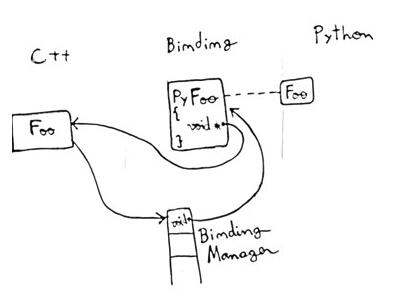您好,登錄后才能下訂單哦!
您好,登錄后才能下訂單哦!
怎么在Python項目中調用C++進行封裝?針對這個問題,這篇文章詳細介紹了相對應的分析和解答,希望可以幫助更多想解決這個問題的小伙伴找到更簡單易行的方法。
Python主要應用于:1、Web開發;2、數據科學研究;3、網絡爬蟲;4、嵌入式應用開發;5、游戲開發;6、桌面應用開發。

配置為Release平臺,不然numpy的頭文件無法被包含,導致編譯器鏈接出錯。
特別要注意的一點是用cmd生成pyd文件時,VS2013可能要輸入: SET VS90COMNTOOLS=%VS120COMNTOOLS%(每次重新打開cmd窗口運行pythonsetup.py build的時候都要輸入一次)才能生成成功。

Python中的代碼通過CPython等將語句解釋為C/C++語言,然后編譯器調用binding入口函數,將傳進來的PyObject*參數通過PyFloat_AsDouble()等轉換成C/C++變量。
這些作為輸入變量傳進已經寫好的C++函數,調用該函數,返回C++結果。最后反過來,將C/C++變量轉成CPython可以識別的PyObject*對象返回給python編譯器(如函數PyFloat_FromDouble()),完成python到C++的調用。
當C/C++里面的輸入變量或者返回值都不是基本類型時,比如自定義的類,那我們同樣要按照類里面定義數據的方式以數據的方式來對應改成python能識別的基本類型的組合。
//以Mat的allocator作為基類,Numpy的Allocator作為繼承類
//這樣可以用派生對象指針對基類數據進行操作
class NumpyAllocator : public MatAllocator
{
public:
NumpyAllocator() { stdAllocator = Mat::getStdAllocator(); }
~NumpyAllocator() {}
UMatData* allocate(PyObject* o, int dims, const int* sizes, int type, size_t* step) const
{
UMatData* u = new UMatData(this);
u->data = u->origdata = (uchar*)PyArray_DATA((PyArrayObject*) o);
npy_intp* _strides = PyArray_STRIDES((PyArrayObject*) o);
for( int i = 0; i < dims - 1; i++ )
step[i] = (size_t)_strides[i];
step[dims-1] = CV_ELEM_SIZE(type);
u->size = sizes[0]*step[0];
u->userdata = o;
return u;
}
UMatData* allocate(int dims0, const int* sizes, int type, void* data, size_t* step, int flags, UMatUsageFlags usageFlags) const
{
if( data != 0 )
{
CV_Error(Error::StsAssert, "The data should normally be NULL!");
// probably this is safe to do in such extreme case
return stdAllocator->allocate(dims0, sizes, type, data, step, flags, usageFlags);
}
//確保當前使用python的C API是線程安全的
PyEnsureGIL gil;
int depth = CV_MAT_DEPTH(type);
int cn = CV_MAT_CN(type);
const int f = (int)(sizeof(size_t)/8);
int typenum = depth == CV_8U ? NPY_UBYTE : depth == CV_8S ? NPY_BYTE :
depth == CV_16U ? NPY_USHORT : depth == CV_16S ? NPY_SHORT :
depth == CV_32S ? NPY_INT : depth == CV_32F ? NPY_FLOAT :
depth == CV_64F ? NPY_DOUBLE : f*NPY_ULONGLONG + (f^1)*NPY_UINT;
int i, dims = dims0;
cv::AutoBuffer<npy_intp> _sizes(dims + 1);
for( i = 0; i < dims; i++ )
_sizes[i] = sizes[i];
if( cn > 1 )
_sizes[dims++] = cn;
PyObject* o = PyArray_SimpleNew(dims, _sizes, typenum);
if(!o)
CV_Error_(Error::StsError, ("The numpy array of typenum=%d, ndims=%d can not be created", typenum, dims));
return allocate(o, dims0, sizes, type, step);
}
bool allocate(UMatData* u, int accessFlags, UMatUsageFlags usageFlags) const
{
return stdAllocator->allocate(u, accessFlags, usageFlags);
}
void deallocate(UMatData* u) const
{
if(!u)
return;
PyEnsureGIL gil;
CV_Assert(u->urefcount >= 0);
CV_Assert(u->refcount >= 0);
if(u->refcount == 0)
{
PyObject* o = (PyObject*)u->userdata;
Py_XDECREF(o);
delete u;
}
}
//基類指針,調用allocate函數進行內存分配
const MatAllocator* stdAllocator;
};上面是先構造好能夠相互交互的allocator。
//將PyObject的特性幅值給size,ndims,type
int typenum = PyArray_TYPE(oarr), new_typenum = typenum;
int type = typenum == NPY_UBYTE ? CV_8U :
typenum == NPY_BYTE ? CV_8S :
typenum == NPY_USHORT ? CV_16U :
typenum == NPY_SHORT ? CV_16S :
typenum == NPY_INT ? CV_32S :
typenum == NPY_INT32 ? CV_32S :
typenum == NPY_FLOAT ? CV_32F :
typenum == NPY_DOUBLE ? CV_64F : -1;
//....
int ndims = PyArray_NDIM(oarr);
//....
const npy_intp* _sizes = PyArray_DIMS(oarr);
const npy_intp* _strides = PyArray_STRIDES(oarr);
for ( int i = ndims - 1; i >= 0; --i )
{
size[i] = (int)_sizes[i];
if ( size[i] > 1 )
{
step[i] = (size_t)_strides[i];
default_step = step[i] * size[i];
}
else
{
step[i] = default_step;
default_step *= size[i];
}
}
//....
//這一步直接用PyObject初始化Mat m
m = Mat(ndims, size, type, PyArray_DATA(oarr), step);
m.u = g_numpyAllocator.allocate(o, ndims, size, type, step);
m.addref();上面是將PyObject對象轉為Mat的部分代碼,具體可以參考opencv的cv2.cpp文件:..\OpenCV\sources\modules\python\src2
//將Mat轉換為PyObject*
template<>
PyObject* pyopencv_from(const Mat& m)
{
if( !m.data )
Py_RETURN_NONE;
Mat temp, *p = (Mat*)&m;
//確保數據拷貝不會對原始數據m產生破壞
if(!p->u || p->allocator != &g_numpyAllocator)
{
temp.allocator = &g_numpyAllocator;
ERRWRAP2(m.copyTo(temp));
p = &temp;
}
//將Mat封裝好的userdata指針轉給Pyobject*
PyObject* o = (PyObject*)p->u->userdata;
//引用計數器加一
Py_INCREF(o);
return o;
}一個很重要的知識點是,pyd文件跟dll文件非常相似,所以生成dll比較困難的C++代碼同樣難以生成pyd,C++跟python編譯器各自編譯特性的區別也會使得轉換存在困難,比如C++的動態編譯。
類;構造函數和析構函數;虛函數;(多重)公有繼承;
靜態函數;重載(包括大多數操作符重載);引用;
模板編程(特化和成員模板);命名空間;默認參數;智能指針。
下面是不能或者比較困難進行轉換的C++特性:
嵌套類;特定操作符的重載比如new和delete。
關于怎么在Python項目中調用C++進行封裝問題的解答就分享到這里了,希望以上內容可以對大家有一定的幫助,如果你還有很多疑惑沒有解開,可以關注億速云行業資訊頻道了解更多相關知識。
免責聲明:本站發布的內容(圖片、視頻和文字)以原創、轉載和分享為主,文章觀點不代表本網站立場,如果涉及侵權請聯系站長郵箱:is@yisu.com進行舉報,并提供相關證據,一經查實,將立刻刪除涉嫌侵權內容。